This article needs additional citations for verification .(August 2015) |
The Bagratuni family tree describes the heritage of the Bagratuni family in Armenia (Bagratuni dynasty). Bagratuni lineage also lays claim to the Georgian Bagrationi dynasty.
This article needs additional citations for verification .(August 2015) |
The Bagratuni family tree describes the heritage of the Bagratuni family in Armenia (Bagratuni dynasty). Bagratuni lineage also lays claim to the Georgian Bagrationi dynasty.

The Bagratuni family became princes in the 4th century. Their heritable rights were given to them by the Arshakuni Dynasty, the kings of Armenia (52–428). They were called aspets and crowned Arshakuni kings. Their domain included the region of Sper in Upper Armenia, which was famous for its gold, and Tayk.
Smbat I was the first member of the dynasty. He was aspet during the reign of Armenia's first Christian king, Tiridates III the Great (287–330). The last Armenian king, who was crowned by Bagratunis, was Artaxias IV (423–428). The aspet was Smbat III, who was known from Vramshapuh king's times (389–415).
| Family of Bagratuni family tree | ||||||||||||||||||||||||||||||||||||||||||||||||||||||||||||||||||||||||||||||||||||||||||||||||||||||||||||||||||||||||||||||||||||||||||||||||||||||||||||||||||||||||||||||||||||||||||||||||||||||||||||||||||||||||||||||||||||||||||||||||||||||||||||||||||||||||||||||||||||||||||||||||||||||||||||||||||||||||||||||||||||||||||||||||||||||||||||||||||||||||||||||||||||||||||||||||||||||||||||||||||||||||||||||||||||||||||||||||||||||||||
|---|---|---|---|---|---|---|---|---|---|---|---|---|---|---|---|---|---|---|---|---|---|---|---|---|---|---|---|---|---|---|---|---|---|---|---|---|---|---|---|---|---|---|---|---|---|---|---|---|---|---|---|---|---|---|---|---|---|---|---|---|---|---|---|---|---|---|---|---|---|---|---|---|---|---|---|---|---|---|---|---|---|---|---|---|---|---|---|---|---|---|---|---|---|---|---|---|---|---|---|---|---|---|---|---|---|---|---|---|---|---|---|---|---|---|---|---|---|---|---|---|---|---|---|---|---|---|---|---|---|---|---|---|---|---|---|---|---|---|---|---|---|---|---|---|---|---|---|---|---|---|---|---|---|---|---|---|---|---|---|---|---|---|---|---|---|---|---|---|---|---|---|---|---|---|---|---|---|---|---|---|---|---|---|---|---|---|---|---|---|---|---|---|---|---|---|---|---|---|---|---|---|---|---|---|---|---|---|---|---|---|---|---|---|---|---|---|---|---|---|---|---|---|---|---|---|---|---|---|---|---|---|---|---|---|---|---|---|---|---|---|---|---|---|---|---|---|---|---|---|---|---|---|---|---|---|---|---|---|---|---|---|---|---|---|---|---|---|---|---|---|---|---|---|---|---|---|---|---|---|---|---|---|---|---|---|---|---|---|---|---|---|---|---|---|---|---|---|---|---|---|---|---|---|---|---|---|---|---|---|---|---|---|---|---|---|---|---|---|---|---|---|---|---|---|---|---|---|---|---|---|---|---|---|---|---|---|---|---|---|---|---|---|---|---|---|---|---|---|---|---|---|---|---|---|---|---|---|---|---|---|---|---|---|---|---|---|---|---|---|---|---|---|---|---|---|---|---|---|---|---|---|---|---|---|---|---|---|---|---|---|---|---|---|---|---|---|---|---|---|---|---|---|---|---|---|---|---|---|---|---|---|---|---|---|---|---|---|---|---|---|---|---|---|---|---|---|---|---|---|---|---|---|---|---|---|---|---|---|---|---|---|---|
| ||||||||||||||||||||||||||||||||||||||||||||||||||||||||||||||||||||||||||||||||||||||||||||||||||||||||||||||||||||||||||||||||||||||||||||||||||||||||||||||||||||||||||||||||||||||||||||||||||||||||||||||||||||||||||||||||||||||||||||||||||||||||||||||||||||||||||||||||||||||||||||||||||||||||||||||||||||||||||||||||||||||||||||||||||||||||||||||||||||||||||||||||||||||||||||||||||||||||||||||||||||||||||||||||||||||||||||||||||||||||||
The ancestors of Smbat III were the most famous princes (nakharars) during the occupation of the Roman Empire and Sassanid Persia. Armenia had been divided between them since 387. Tirots, one of the ancestors of Smbat III, allied with Armenian marzbane. Sahak II and Smbat IV were marzbans of Armenia. The rulers of the dynasty traditionally continued to be "aspets".
After the second division of Armenia, the domains of the Bagratuni family became part of Byzantine Empire. Smbat IV was among the princes who rebelled against them.
| History of Armenia |
|---|
 |
| Timeline • Origins • Etymology |
| Family of Bagratuni family tree | ||||||||||||||||||||||||||||||||||||||||||||||||||||||||||||||||||||||||||||||||||||||||||||||||||||||||||||||||||||||||||||||||||||||||||||||||||||||||||||||||||||||||||||||||||||||||||||||||||||||||||||||||||||||||||||||||||||||||||||||||||||||||||||||||||||||||||||||||||||||||||||||||||||||||||||||||||||||||||||||||||||||||||||||||||||||||||||||||||||||||||||||||||||||||||||||||||||||||||||||||||||||||||||||||||||||||||||||||||
|---|---|---|---|---|---|---|---|---|---|---|---|---|---|---|---|---|---|---|---|---|---|---|---|---|---|---|---|---|---|---|---|---|---|---|---|---|---|---|---|---|---|---|---|---|---|---|---|---|---|---|---|---|---|---|---|---|---|---|---|---|---|---|---|---|---|---|---|---|---|---|---|---|---|---|---|---|---|---|---|---|---|---|---|---|---|---|---|---|---|---|---|---|---|---|---|---|---|---|---|---|---|---|---|---|---|---|---|---|---|---|---|---|---|---|---|---|---|---|---|---|---|---|---|---|---|---|---|---|---|---|---|---|---|---|---|---|---|---|---|---|---|---|---|---|---|---|---|---|---|---|---|---|---|---|---|---|---|---|---|---|---|---|---|---|---|---|---|---|---|---|---|---|---|---|---|---|---|---|---|---|---|---|---|---|---|---|---|---|---|---|---|---|---|---|---|---|---|---|---|---|---|---|---|---|---|---|---|---|---|---|---|---|---|---|---|---|---|---|---|---|---|---|---|---|---|---|---|---|---|---|---|---|---|---|---|---|---|---|---|---|---|---|---|---|---|---|---|---|---|---|---|---|---|---|---|---|---|---|---|---|---|---|---|---|---|---|---|---|---|---|---|---|---|---|---|---|---|---|---|---|---|---|---|---|---|---|---|---|---|---|---|---|---|---|---|---|---|---|---|---|---|---|---|---|---|---|---|---|---|---|---|---|---|---|---|---|---|---|---|---|---|---|---|---|---|---|---|---|---|---|---|---|---|---|---|---|---|---|---|---|---|---|---|---|---|---|---|---|---|---|---|---|---|---|---|---|---|---|---|---|---|---|---|---|---|---|---|---|---|---|---|---|---|---|---|---|---|---|---|---|---|---|---|---|---|---|---|---|---|---|---|---|---|---|---|---|---|---|---|---|---|---|---|---|---|---|---|---|---|---|---|---|---|---|---|---|---|---|---|---|---|---|---|---|---|---|---|---|---|---|---|---|---|---|
| ||||||||||||||||||||||||||||||||||||||||||||||||||||||||||||||||||||||||||||||||||||||||||||||||||||||||||||||||||||||||||||||||||||||||||||||||||||||||||||||||||||||||||||||||||||||||||||||||||||||||||||||||||||||||||||||||||||||||||||||||||||||||||||||||||||||||||||||||||||||||||||||||||||||||||||||||||||||||||||||||||||||||||||||||||||||||||||||||||||||||||||||||||||||||||||||||||||||||||||||||||||||||||||||||||||||||||||||||||

During the Arabic period (7–9th centuries), the Bagratuni family was one of the most powerful princely dynasties of Armenia. Their main competitors were sparapets of the Mamikonian family who were Byzantine-oriented. Princes of Armenia were chosen from these two families and sometimes the people, who were under their influence. Princes were the second most powerful people after the ostikan.[ citation needed ]
The competition was ended by the victory of Bagratunis, who founded an independent kingdom. First, the title of Prince of Armenia changed to Prince of Princes. Then, the prince of princes became sparapets who were the constables of the army. In the beginning of the 9th century, a powerful prince, Ashot Msaker, united Taron, Tayk and Ayrarat, taking them under his control and thus making them part of his domain. Later, he united Moxoene, Gugark, Georgia and Caucasian Albania. He then took over Artsrunis of Vaspurakan and Syunis of Syunik. As a result, all of Arminiya came under his control.[ citation needed ]
Princes of Armenia and sparapets were from the family of Smbat VIII. His son, Ashot, became the king of Armenia. Sons of Bagarat II, brother of Smbat VIII, became the princes of Taron. Their sister, Hripsime, became the princess of principality of Vaspurakan. Her husband was the first prince Hamazasp II, Artsruni.[ citation needed ]
Before independence, the Tayk of Bagratuni became an independent principality.[ citation needed ] Its ruler, Ashot, became the head of the Georgian Bagrationi dynasty. It ruled in Georgia for one thousand years (9–19th centuries).
The last prince of Armenia was Ashot (855–885), son of Smbat VIII, who later became the first king (885–890).
| Family of Bagratuni family tree | ||||||||||||||||||||||||||||||||||||||||||||||||||||||||||||||||||||||||||||||||||||||||||||||||||||||||||||||||||||||||||||||||||||||||||||||||||||||||||||||||||||||||||||||||||||||||||||||||||||||||||||||||||||||||||||||||||||||||||||||||||||||||||||||||||||||||||||||||||||||||||||||||||||||||||||||||||||||||||||||||||||||||||||||||||||||||||||||||||||||||||||||||||||||||||||||||||||||||||||||||||||||||||||||||||||||||||||||||||||||||||||||||||||||||||||||||||||||||||||||||||||||||||||||||||||||||||||||||||||||||||||||||||||||||||||||||||||||||||||||||||||||||||||||||||||||||||||||||||||||||||||||||||||||||||||||||||||||||||||||||||||||||||||||||||||||||||||||||||||||||||||||||||||||||||||||||||||||||||||||||||||||||||||||||||||||||||||||||||||||||||||||||||||||
|---|---|---|---|---|---|---|---|---|---|---|---|---|---|---|---|---|---|---|---|---|---|---|---|---|---|---|---|---|---|---|---|---|---|---|---|---|---|---|---|---|---|---|---|---|---|---|---|---|---|---|---|---|---|---|---|---|---|---|---|---|---|---|---|---|---|---|---|---|---|---|---|---|---|---|---|---|---|---|---|---|---|---|---|---|---|---|---|---|---|---|---|---|---|---|---|---|---|---|---|---|---|---|---|---|---|---|---|---|---|---|---|---|---|---|---|---|---|---|---|---|---|---|---|---|---|---|---|---|---|---|---|---|---|---|---|---|---|---|---|---|---|---|---|---|---|---|---|---|---|---|---|---|---|---|---|---|---|---|---|---|---|---|---|---|---|---|---|---|---|---|---|---|---|---|---|---|---|---|---|---|---|---|---|---|---|---|---|---|---|---|---|---|---|---|---|---|---|---|---|---|---|---|---|---|---|---|---|---|---|---|---|---|---|---|---|---|---|---|---|---|---|---|---|---|---|---|---|---|---|---|---|---|---|---|---|---|---|---|---|---|---|---|---|---|---|---|---|---|---|---|---|---|---|---|---|---|---|---|---|---|---|---|---|---|---|---|---|---|---|---|---|---|---|---|---|---|---|---|---|---|---|---|---|---|---|---|---|---|---|---|---|---|---|---|---|---|---|---|---|---|---|---|---|---|---|---|---|---|---|---|---|---|---|---|---|---|---|---|---|---|---|---|---|---|---|---|---|---|---|---|---|---|---|---|---|---|---|---|---|---|---|---|---|---|---|---|---|---|---|---|---|---|---|---|---|---|---|---|---|---|---|---|---|---|---|---|---|---|---|---|---|---|---|---|---|---|---|---|---|---|---|---|---|---|---|---|---|---|---|---|---|---|---|---|---|---|---|---|---|---|---|---|---|---|---|---|---|---|---|---|---|---|---|---|---|---|---|---|---|---|---|---|---|---|---|---|---|---|---|---|---|---|---|---|---|---|---|---|---|---|---|---|---|---|---|---|---|---|---|---|---|---|---|---|---|---|---|---|---|---|---|---|---|---|---|---|---|---|---|---|---|---|---|---|---|---|---|---|---|---|---|---|---|---|---|---|---|---|---|---|---|---|---|---|---|---|---|---|---|---|---|---|---|---|---|---|---|---|---|---|---|---|---|---|---|---|---|---|---|---|---|---|---|---|---|---|---|---|---|---|---|---|---|---|---|---|---|---|---|---|---|---|---|---|---|---|---|---|---|---|---|---|---|---|---|---|---|---|---|---|---|---|---|---|---|---|---|---|---|---|---|---|---|---|---|---|---|---|---|---|---|---|---|---|---|---|---|---|---|---|---|---|---|---|---|---|---|---|---|---|---|---|---|---|---|---|---|---|---|---|---|---|---|---|---|---|---|---|---|---|---|---|---|---|---|---|---|---|---|---|---|---|---|---|---|---|---|---|---|---|---|---|---|---|---|---|---|---|---|---|---|---|---|---|---|---|---|---|---|---|---|---|---|---|---|---|---|---|---|---|---|---|---|---|---|---|---|---|---|---|---|---|---|---|---|---|---|---|---|---|---|---|---|---|---|---|---|---|---|---|---|---|---|---|---|---|---|---|---|---|---|---|---|---|---|---|---|---|---|---|---|---|---|---|---|---|---|---|---|---|---|---|---|---|---|---|---|---|---|---|---|---|---|---|---|---|---|---|---|---|---|---|---|---|---|---|---|---|---|---|---|---|---|---|---|---|---|---|---|---|---|---|---|---|
| ||||||||||||||||||||||||||||||||||||||||||||||||||||||||||||||||||||||||||||||||||||||||||||||||||||||||||||||||||||||||||||||||||||||||||||||||||||||||||||||||||||||||||||||||||||||||||||||||||||||||||||||||||||||||||||||||||||||||||||||||||||||||||||||||||||||||||||||||||||||||||||||||||||||||||||||||||||||||||||||||||||||||||||||||||||||||||||||||||||||||||||||||||||||||||||||||||||||||||||||||||||||||||||||||||||||||||||||||||||||||||||||||||||||||||||||||||||||||||||||||||||||||||||||||||||||||||||||||||||||||||||||||||||||||||||||||||||||||||||||||||||||||||||||||||||||||||||||||||||||||||||||||||||||||||||||||||||||||||||||||||||||||||||||||||||||||||||||||||||||||||||||||||||||||||||||||||||||||||||||||||||||||||||||||||||||||||||||||||||||||||||||||||||||

Taron (Turuberan) became a part of Bagratunis' domain in the beginning of the 9th century, when Ashot Msaker was Prince of Armenia (790–826). As a prince of Taron, he is counted as Ashot I (804–826). After his death, prince of princes, Bagrat, inherited Taron, the south of the domain, and Smbat, Ayrarat, which was the northern part. Bagrat was the second in the dynasty. Bagrat I was an aspet in the 4th century. However, in Taron, he was the first Bagrat, so he ruled as Bagrat I of Taron (826–851), because there were no Bagrats before him. His sons and grandsons ruled until 966. After, Taron became a part of Byzantine Empire.[ citation needed ]
Previous seniors, princes of Taron, of the Mamikonian family, were strong in the region, even during the ruling of the last prince, Ashot III. They became relatives with the Bagratunis, and as a result of that, there were two more princes in Taron in his last days. They were Bagrat III and Grigor II, who were half-Mamikonians and half-Bagratunis. Later, the Tronite branch of the Bagratunis and Mamikonians became one family. Some of them ruled in Sasun (Tornikians) and the others in Moush (Taronites).[ citation needed ]
| Family of Bagratuni family tree | ||||||||||||||||||||||||||||||||||||||||||||||||||||||||||||||||||||||||||||||||||||||||||||||||||||||||||||||||||||||||||||||||||||||||||||||||||||||||||||||||||||||||||||||||||||||||||||||||||||||||||||||||||||||||||||||||||||||||||||||||||||||||||||||||||||||||||||||||||||||||||||||||||||||||||||||||||||||||||||||||||||||||||||||||||||||||||||||||||||||||||||||||||
|---|---|---|---|---|---|---|---|---|---|---|---|---|---|---|---|---|---|---|---|---|---|---|---|---|---|---|---|---|---|---|---|---|---|---|---|---|---|---|---|---|---|---|---|---|---|---|---|---|---|---|---|---|---|---|---|---|---|---|---|---|---|---|---|---|---|---|---|---|---|---|---|---|---|---|---|---|---|---|---|---|---|---|---|---|---|---|---|---|---|---|---|---|---|---|---|---|---|---|---|---|---|---|---|---|---|---|---|---|---|---|---|---|---|---|---|---|---|---|---|---|---|---|---|---|---|---|---|---|---|---|---|---|---|---|---|---|---|---|---|---|---|---|---|---|---|---|---|---|---|---|---|---|---|---|---|---|---|---|---|---|---|---|---|---|---|---|---|---|---|---|---|---|---|---|---|---|---|---|---|---|---|---|---|---|---|---|---|---|---|---|---|---|---|---|---|---|---|---|---|---|---|---|---|---|---|---|---|---|---|---|---|---|---|---|---|---|---|---|---|---|---|---|---|---|---|---|---|---|---|---|---|---|---|---|---|---|---|---|---|---|---|---|---|---|---|---|---|---|---|---|---|---|---|---|---|---|---|---|---|---|---|---|---|---|---|---|---|---|---|---|---|---|---|---|---|---|---|---|---|---|---|---|---|---|---|---|---|---|---|---|---|---|---|---|---|---|---|---|---|---|---|---|---|---|---|---|---|---|---|---|---|---|---|---|---|---|---|---|---|---|---|---|---|---|---|---|---|---|---|---|---|---|---|---|---|---|---|---|---|---|---|---|---|---|---|---|---|---|---|---|---|---|---|---|---|---|---|---|---|---|---|---|---|---|---|---|---|---|---|---|
| ||||||||||||||||||||||||||||||||||||||||||||||||||||||||||||||||||||||||||||||||||||||||||||||||||||||||||||||||||||||||||||||||||||||||||||||||||||||||||||||||||||||||||||||||||||||||||||||||||||||||||||||||||||||||||||||||||||||||||||||||||||||||||||||||||||||||||||||||||||||||||||||||||||||||||||||||||||||||||||||||||||||||||||||||||||||||||||||||||||||||||||||||||
After the death of Ashot Msaker (826) and Bagrat II Bagratuni (851), Smbat VIII became the prince of Armenia. His family was the ruling royal family for 200 years, in Armenia, Georgia and Albania. Because of this long rule, they were called king of kings (shahnshah).
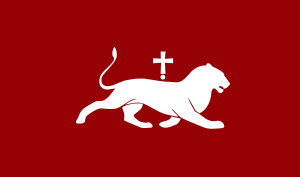
The son of Smbat VIII, Ashot, became the first Bagratuni king. He had four sons and three daughters, whom he married to Artsruni and Syuni princes. Thus, the strongest families of Armenia became one family and began to rule the country. Ashot's brother, Shapuh, became sparapet, the constable of the Armenian army. The capital was Bagaran, which was throne-city of Ashot Msaker (790–826). Ashot 's son, Smbat (890–914), moved the capital to Yerazgavors. It was the capital for about forty years until King Abas moved it to Kars.
Ashot III the Merciful, king of Armenia (953–977), built a new capital around the fortress of Ani. It was the last capital of the Armenian kingdom, so it is also called Kingdom of Ani. His brother, Mushegh, stayed in Kars and founded Kingdom of Kars (963–1065) under the sovereignty of Ashot III. Later, the king of Armenia, Smbat II, allowed his brother Gurgen to organize a new kingdom in north which became the Kingdom of Tashir-Dzoraget (978–1113). Smbat Syuni did the same in the east creating the Kingdom of Syunik-Baghk.
The third son of Ashot III, Gagik, was the last powerful king of Armenia (990–1020). After his death, the kingdom was divided into two parts, between the brothers, Hovhannes-Smbat and Ashot. The last king was Gagik II (1042–1045), son of Ashot.
In 1079, Gagik II was killed. In 1080, Gagik of Kars and his sons, Hovhannes and David, also died. The son of Hovhannes, Ashot, was also killed in Ani. As a result, the royal branch of the Bagratunis ended with Ani and Kars. The last royal branch, the Kiurikian family, remained in Lori.
Armenian prince Ruben killed the murderers of Gagik II and inherited the throne from him. In 1080, he founded the Armenian principality of Cilicia (1080-1198), which became a kingdom (1198–1375).
Consequently, the royal heritage of the Armenian Bagratuni family is either Georgian Bagrationis, or Rubinians, Hetumids and Lusignans in Cilicia, or the Kiurikians. Non-royal or princely branches have many more than these three royal branches.[ citation needed ][ original research? ]
| Smbat VIII (852–855) | Hripsime | ||||||||||||||||||||||||||||||||||||||||||||||||||||||||||||
| Katranide I | Ashot I (855–885) (885–890) | Smbat | Shapuh | Mushegh | Abas | two daughters | |||||||||||||||||||||||||||||||||||||||||||||||||||||||
| Smbat the Martyr (890–914) | Sahak | David | Shapuh sparapet | ||||||||||||||||||||||||||||||||||||||||||||||||||||||||||
| Sofya | Grigor Artsruni Vaspurakan (857–887) | daughter | Vahan Artsruni | Mariam | Vasak Syuni Syunik (855–859) | ||||||||||||||||||||||||||||||||||||||||||||||||||||||||
| Ashot Vaspurakan (898–904) | Gagik prince and king of Vaspurakan (904–908, 908–943) | Gurgen (904–925) | Grigor Syunik (859–913) | Sahak | Vasak | ||||||||||||||||||||||||||||||||||||||||||||||||||||||||
| Ashot the Iron (914–928) | Sahakanuysh Sevada | Abas I (928–953) | Gagik Vaspurakan (897–898) | son | Ashot sparapet | ||||||||||||||||||||||||||||||||||||||||||||||||||||||||
| Khosrovanuysh | Ashot III (953–977) | Mushegh I Kars (963–984) | daughter of Sevada II | ||||||||||||||||||||||||||||||||||||||||||||||||||||||||||
| Smbat II (977–990) | Gagik I (990–1020) | Katranide II | Gurgen Lori (978–989) | Abas I Kars (984–1029) | Gourandukht Rubinyan | ||||||||||||||||||||||||||||||||||||||||||||||||||||||||
| Senekerim Artsruni Vaspurakan (1003–1021) | Khushush | Hovhannes-Smbat (1022–1041) | Ashot the Brave (1022–1040) | Abas | Kiurikians | Gagik I Kars (1029–1065) | |||||||||||||||||||||||||||||||||||||||||||||||||||||||
| daughter of David Artsruni | Gagik II | Mariam | |||||||||||||||||||||||||||||||||||||||||||||||||||||||||||
| Hovhannes | David | daughter of Ablgarib Artsruni | |||||||||||||||||||||||||||||||||||||||||||||||||||||||||||
| Ashot († 1080) | |||||||||||||||||||||||||||||||||||||||||||||||||||||||||||||

The Kiurikians were a royal and princely family from Armenia from the 10th through 14th centuries. The founder is Gurgen or Kiurike, son of Ashot III the Merciful (953–977). At first, they ruled only in Tashir-Dzoraget (Lori Province) but later in Tavush as well. Grandsons of Gurgen-Kiurike were kings of Tashir-Dzoraget and eastern Georgia (Kingdom of Kakheti).
In the 12th century, Kakhety and Lori annexed to Georgia. The Kiurikians remained in Tavush. Later they divided into Matsnaberd and Nor-berd branches. The last prince, Sargis of Matsnaberd, ruled in the 13th century. Nothing is known about him, his parents (probably Aghsartan), or their offspring.
| Gurgen (978–989) Lori | |||||||||||||||||||||||||||||||||||||||||||
| David I (989–1048) Lori | |||||||||||||||||||||||||||||||||||||||||||
| Kiurike II (1048–1089) Lori | Gagik († 1058) Kakhet | ||||||||||||||||||||||||||||||||||||||||||
| David II (1089–1113) Lori | Abas I (1089–1113) Lori | Aghsartan I († 1084) Kakhet | |||||||||||||||||||||||||||||||||||||||||
| Kiurike III Tavush | Kiurike IV († 1102) Kakhet | ||||||||||||||||||||||||||||||||||||||||||
| Abas II Tavush | Aghsartan II († 1105) Kakhet | ||||||||||||||||||||||||||||||||||||||||||
| Aghsartan I Matsnaberd | Vasak I Nor Berd | ||||||||||||||||||||||||||||||||||||||||||
| Kiurike IV Matsnaberd | David III Nor Berd | ||||||||||||||||||||||||||||||||||||||||||
| Pahlavan Matsnaberd | Taghaiddin Matsnaberd | Aghsartan II Matsnaberd | Vasak II Nor Berd | ||||||||||||||||||||||||||||||||||||||||

The Kingdom of the Iberians was a medieval Georgian monarchy under the Bagrationi dynasty which emerged circa 888 AD, succeeding the Principality of Iberia, in historical region of Tao-Klarjeti, or upper Iberia in north-eastern Turkey as well parts of modern southwestern Georgia, that stretched from the Iberian gates in the south and to the Lesser Caucasus in the north.
Mamikonian, or Mamikonean, was an aristocratic dynasty which dominated Armenian politics between the 4th and 8th centuries. They were the most notable noble house in Early Christian Armenia after the ruling Arsacid dynasty and held the hereditary positions of sparapet and dayeak, allowing them to play the role of kingmaker for the later Armenian kings. They ruled over extensive territories, including the Armenian regions of Tayk, Taron, Sasun, and Bagrevand, among others. The Mamikonians had a reputation as supporters of the Roman Empire in Armenia against Sasanian Iran, although they also served as viceroys under Persian rule. Their influence over Armenian affairs began to decline at the end of the 6th century and suffered a final, decisive blow after a failed rebellion against Arab rule over Armenia in 774/75.
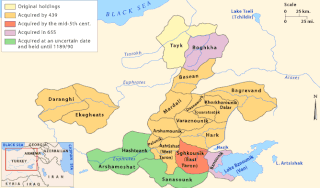
Taron was a canton of the Turuberan province of Greater Armenia, roughly corresponding to the Muş Province of modern Turkey.

Abas was king of Bagratid Armenia from 928 to 953. He was a member of the Bagratid (Bagratuni) royal dynasty. He was the son of Smbat I and the brother of Ashot II the Iron, whom he succeeded. In contrast to the reign of his predecessors, Abas's reign was mostly peaceful, and he occupied himself with the reconstruction of the war-torn kingdom and the development of his capital at Kars.
Smbat I was the second king of the medieval Kingdom of Armenia of the Bagratuni dynasty, and son of Ashot I. He is the father of Ashot II and Abas I.
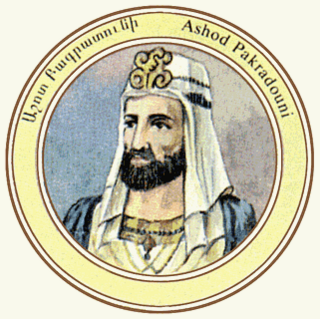
Ashot I was an Armenian king who oversaw the beginning of Armenia's second golden age. He was the son of Smbat VIII the Confessor and was a member of the Bagratuni dynasty.
Gagik II was the last Armenian king of the Bagratuni dynasty. Known as Gagik II King of Ani he was enthroned as Gagik II and ruled for a brief period from 1042 to 1045 before the Bagratid dynasty rule collapsed in Armenia.

Gagik I was the king of Armenia who reigned between 989 and 1020, under whom Bagratid Armenia reached its height, and "enjoyed the accustomed experience of unbroken peace and prosperity."
Vahram Pahlavuni was an Armenian military commander and official in Bagratuni Armenia. He was the head of the noble family of Pahlavuni, who held the hereditary title of sparapet (general-in-chief) in the Bagratuni kingdom of Armenia.

The Kingdom of Tashir-Dzoraget, alternatively known as the Kingdom of Lori or Kiurikian Kingdom by later historians, was a medieval Armenian kingdom formed in the year 979 by the Kiurikian dynasty, a branch of the Bagratuni dynasty, as a vassal kingdom of the Bagratid Kingdom of Armenia. The first capital of the kingdom was Matsnaberd, currently part of modern-day Azerbaijan.
Ashot IV Bagratuni, better known as Ashot Msaker, reputedly for his refusal to refrain from eating meat during Lent, was an Armenian prince from the Bagratid family. A fugitive from the failed uprising in 775 against Arab rule in Armenia, where his father was killed, over the next decades he gradually expanded his domains and established a predominant role for himself in the country's affairs, becoming recognized by the Abbasid Caliphate as presiding prince of Armenia from 806 until his death in 826.
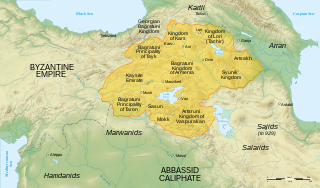
Bagratid Armenia was an independent Armenian state established by Ashot I Bagratuni of the Bagratuni dynasty in the early 880s following nearly two centuries of foreign domination of Greater Armenia under Arab Umayyad and Abbasid rule. With each of the two contemporary powers in the region—the Abbasids and Byzantines—too preoccupied to concentrate their forces in subjugating the region, and with the dissipation of several of the Armenian nakharar noble families, Ashot succeeded in asserting himself as the leading figure of a movement to dislodge the Arabs from Armenia.

Ashot III was a king of Armenia, ruling the medieval kingdom of Armenia from 952/53–77. Known as Ashot III the Merciful and acknowledged by foreign rulers as the Shahanshah of Mets Hayk', he moved his royal seat of residence to Ani and oversaw its development and of the kingdom as a whole. Armenia reached the height of its golden era during his reign and that of his sons and successors, Smbat II (977–89) and Gagik I (990–1020).
Ashot IV, surnamed Kaj, i.e. "the Brave, the Valiant", was the younger son of King Gagik I of Armenia.
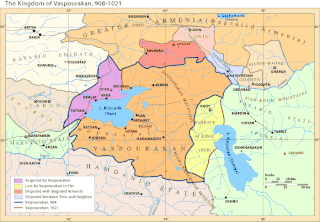
The Kingdom of Vaspurakan was a medieval Armenian kingdom centered on Lake Van, located in what is now eastern Turkey and northwestern Iran. It was named after Vaspurakan, a province of historic Greater Armenia. Ruled by the Artsruni dynasty, it competed and cooperated with the Bagratuni-ruled Kingdom of Armenia for a little over a century until its last king ceded the kingdom to the Byzantine Empire in 1021.

The Bagratuni or Bagratid dynasty was an Armenian royal dynasty which ruled the medieval Kingdom of Armenia from c. 885 until 1045. Originating as vassals of the Kingdom of Armenia of antiquity, they rose to become the most prominent Armenian noble family during the period of Arab rule in Armenia, eventually establishing their own independent kingdom. Their domain included regions of Armenia such as Shirak, Bagrevand, Kogovit, Syunik, Lori, Vaspurakan, Vanand and Taron. Many historians, such as Cyril Toumanoff, Nicholas Adontz and Ronald Suny, consider them to be the progenitors of the Georgian royal Bagrationi dynasty.
Bagrat II Bagratuni was an Armenian noble of the Bagratid (Bagratuni) family and the presiding prince of Arab-ruled Armenia between 830 and 851. He succeeded his father, Ashot IV Bagratuni, as ruler of Taron in 826, and was named presiding prince by the Abbasid Caliph in 830. In 849 he began an open rebellion against Abbasid authority in Armenia. The rebellion provoked the dispatch of Bugha al-Kabir to the country, who crushed the revolt in a three-year campaign. Bagrat was treacherously captured during negotiations in 851 and brought captive to the Abbasid capital Samarra. He was succeeded in Taron by his sons, while the title of presiding prince passed to his nephew, the future King Ashot I of Armenia.
Smbat VIII Bagratuni or Smbat the Confessor was an Armenian noble of the Bagratid (Bagratuni) family and one of the most important princes (nakharar) of Armenia in the mid-9th century as the commander-in-chief (sparapet) of Armenia. Taken prisoner to Samarra, he was pressured to convert to Islam but refused and died there. He was the father of Ashot I of Armenia, founder of the Bagratid Kingdom of Armenia.

The Kiurikian or Kiurikid dynasty was a medieval Armenian royal dynasty which ruled the kingdoms of Tashir-Dzoraget (978-1118) and Kakheti-Hereti (1029/1038-1105). They originated as a junior branch and vassals of the Bagratid dynasty, but outlived the main branch of the dynasty after the fall of the Bagratid Kingdom of Armenia. They became vassals of the Seljuk Turks in the second half of the 1060s. After the fall of the Kingdom of Tashir-Dzoraget to the Seljuks in the early 12th century, members of the dynasty continued to rule from their fortresses of Tavush, Matsnaberd and Nor Berd until the 13th century.